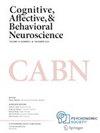将强迫行为模型的转化价值最大化:对皮肯汉等人(2024)的评论。
IF 2.5
3区 医学
Q2 BEHAVIORAL SCIENCES
Cognitive Affective & Behavioral Neuroscience
Pub Date : 2024-04-01
Epub Date: 2024-03-07
DOI:10.3758/s13415-024-01175-y
引用次数: 0
摘要
在本期《认知、情感和行为神经科学》(Cognitive, Affective, and Behavioral Neuroscience)杂志上,Pickenhan 等人(2024 年)讨论了开展转化研究以了解强迫症(OCD)基本特征的必要性。他们强调了观察-反应任务(ORT)在模拟功能性和不适应性检查行为(强迫症的常见症状)方面的转化价值。本文章由计算机程序翻译,如有差异,请以英文原文为准。
Maximizing translational value in models of compulsive behavior: A commentary on Pickenhan et al. (2024).
In this issue of Cognitive, Affective, and Behavioral Neuroscience, Pickenhan et al. (2024) discuss the need for translational studies to understand features underlying obsessive-compulsive disorder (OCD). They highlight the translational value of the observing-response task (ORT) for modeling functional and maladaptive checking behaviors, a common symptom of OCD.
求助全文
通过发布文献求助,成功后即可免费获取论文全文。
去求助
来源期刊
CiteScore
5.00
自引率
3.40%
发文量
64
审稿时长
6-12 weeks
期刊介绍:
Cognitive, Affective, & Behavioral Neuroscience (CABN) offers theoretical, review, and primary research articles on behavior and brain processes in humans. Coverage includes normal function as well as patients with injuries or processes that influence brain function: neurological disorders, including both healthy and disordered aging; and psychiatric disorders such as schizophrenia and depression. CABN is the leading vehicle for strongly psychologically motivated studies of brain–behavior relationships, through the presentation of papers that integrate psychological theory and the conduct and interpretation of the neuroscientific data. The range of topics includes perception, attention, memory, language, problem solving, reasoning, and decision-making; emotional processes, motivation, reward prediction, and affective states; and individual differences in relevant domains, including personality. Cognitive, Affective, & Behavioral Neuroscience is a publication of the Psychonomic Society.

 求助内容:
求助内容: 应助结果提醒方式:
应助结果提醒方式:


